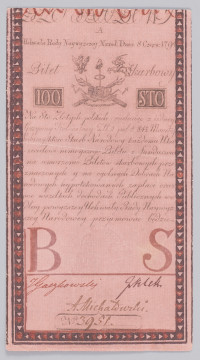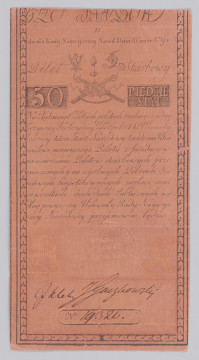
Treasury ticket - 500 Polish zlotys
1794
National Museum in Lublin
Part of the collection: Paper money of the Kościuszko Uprising and the Duchy of Warsaw
The introduction into circulation of the first paper money in the history of Poland required the authorities to apply safeguards against counterfeiting. The problem was worked out extremely carefully when the planned treasury tickets with the denominations of 5, 10, 25, 50, 100, 500 and 1000 zlotys were introduced into circulation. Market needs forced the insurgent authorities to supplement the denominations with five- and ten-grosz money, as well as one- and four-grosz money, which was prepared in a simplified way, discussed in the description of the five-groszy ticket. The lack of previous experience necessitated the use of original solutions. One of the most important was the use of an innovative method developed by J. Kapostas, the main designer of the graphic design of the tickets, and chemist J.F. Zeidl. It consisted in chemical colouring of the paper around the letters S and B, which stood for ‘Revenue Ticket’. The method proved to be extremely effective, and the manner it was used remains unknown to this day. Another security measure was to affix the imprint of the dry seal of the Directorate of Revenue Tickets. An image of a broken seal was adopted to make forgery more difficult. Three different versions were used, differing in the size of the defect, but all had the inscription ‘Freedom, Wholeness, Independence’. The various denominations differed in the shade of the paper and the design of the decorative frame, which made it difficult to convert lower denominations into higher ones. The range of security features was rounded off through series marks, the consecutive numbering of each ticket, and the signatures of two or three commissioners of the Directorate of Treasury Tickets. While the series mark was printed at the top of the ticket, the numbers were applied by hand when individual tickets were issued, and this was done twice. After printing, the tickets were bound together (at first in 1000, then in 500 pieces), and when issuing, the individual pieces were cut off, keeping a separate section. The same number was written both on the ticket and the slip, which was kept for control purposes. As for the commissioners' signatures, they varied according to the denomination. For example, the signatures of Piotr Grozmani, a councillor of the city of Vilnius, and Michal Zakrzewski, regent of the crown metric, appeared on 25-zloty tickets.
Leszek Poniewozik
Author / creator
Dimensions
cały obiekt: height: 95 mm, width: 182 mm
Object type
paper money
Technique
woodcut
Creation time / dating
Creation / finding place
Owner
The National Museum in Lublin
Identification number
Location / status

1794
National Museum in Lublin

1794
National Museum in Lublin

1794
National Museum in Lublin
DISCOVER this TOPIC
National Museum in Szczecin
DISCOVER this PATH
Educational path